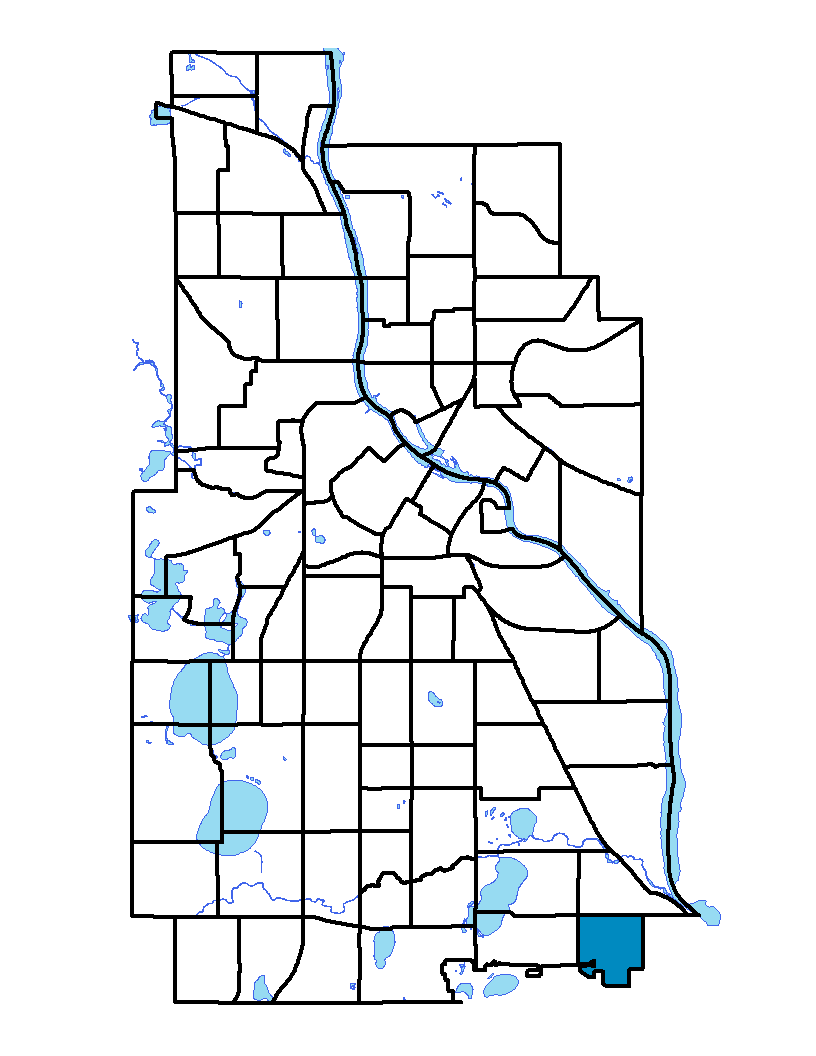Morris Park makes up the southeastern border of Minneapolis. The neighborhood abuts the Twin Cities Air Force Reserve Base on the south, and 54th Street is its northern extent. Morris Park is also bordered by 34th Avenue on the west and 46th Avenue on the east, the latter of which serves as the city border. The neighborhood took its name from Mary C. Morris, daughter of Franklin Steele. Steele was the first European-American settler of the city of St. Anthony (on the east bank of the Mississippi River, in what is now Minneapolis), and he donated land to the University of Minnesota. A majority of the single-family homes were built from the 1920s through the 1960s. A large reason for the development in Morris Park during this time was the availability of streetcar routes and rail lines in this area that date back to 1865. Today, Morris Park is part of the Nokomis community and the Nokomis East Neighborhood Association (NENA). NENA encompasses a total of four neighborhoods. The other neighborhoods are Keewaydin, Minnehaha and Wenonah. Public and shopping amenities abound for Morris Park and the NENA neighborhoods with parks, lakes, a post office, library and shops either in Morris Park or adjacent neighborhoods.
Morris Park, Minnehaha, Keewaydin and Wenonah neighborhoods share a neighborhood association; to learn more visit: http://www.nokomiseast.org
Indicator Details
|
Indicators |
Primary Domain | Indicator Value | Rank | Tier |
|---|---|---|---|---|
| Access to Mainstream Financial Services | Economic Health | 19.2% | 31 | Middle |
| Access to Parks and Open Space | Natural Areas | 1.1% | 75 | Bottom |
| Adult Educational Attainment | Educational Opportunities | 95.8% | 23 | Top |
| Age of Housing | Housing | 95.7% | 76 | Bottom |
| Blood Lead Levels in Children | Housing | 3.6% | 36 | Middle |
| Business Retention | Economic Health | 1.7% | 40 | Middle |
| Chronic School Absence | Health Systems and Public Safety | -% | - | Data N/A |
| Commute Mode Share | Transportation | 13.5% | 82 | Bottom |
| Employment Rate | Employment Opportunities | 69.3% | 39 | Middle |
| Excessive Housing Cost Burden | Housing | 24.5% | 27 | Top |
| Food Desert | Neighborhood Characteristics | -% | - | Data N/A |
| High School Graduation Rate | Educational Opportunities | -% | - | Data N/A |
| Household Transportation Costs | Transportation | 18.9% | 70 | Bottom |
| Local Business Vitality | Economic Health | 72.9% | 1 | Top |
| Long-Term Unemployment | Employment Opportunities | 5.2% | 37 | Middle |
| Low Birth Weight | Health Systems and Public Safety | 7.6% | 47 | Middle |
| Motor Vehicle Collisions | Health Systems and Public Safety | 0.1 | 1 | Top |
| Offsite Alcohol Outlets | Neighborhood Characteristics | - | - | Data N/A |
| Pedestrian Connectivity | Transportation | 120.9 | 49 | Middle |
| Preschool Enrollment | Educational Opportunities | 30.3% | 68 | Bottom |
| Preventable Hospitalizations | Health Systems and Public Safety | 1 | 5 | Top |
| Proximity to Brownfield Sites | Environmental Hazards | 1.4% | 25 | Top |
| Proximity to Superfund Sites | Environmental Hazards | 0.0% | 1 | Top |
| Public Assisted Households | Employment Opportunities | 17.8% | 41 | Middle |
| Reading Proficiency | Educational Opportunities | -% | - | Data N/A |
| Residential Mobility | Social Cohesion | 86.0% | 18 | Top |
| Residential Proximity to Traffic | Environmental Hazards | 21.9% | 58 | Middle |
| School Proximity to Traffic | Environmental Hazards | 0.0% | 1 | Top |
| School Readiness Scores | Educational Opportunities | -% | - | Data N/A |
| Toxic Releases from Facilities | Environmental Hazards | 0.0% | 1 | Top |
| Transit Accessibility | Transportation | 175.8 | 78 | Bottom |
| Travel Time to Work | Employment Opportunities | 21.7 minutes | 32 | Middle |
| Tree Cover | Natural Areas | 26.1% | 65 | Bottom |
| Vacancy Rates | Housing | 3.0% | 6 | Top |
| Violent Crime | Health Systems and Public Safety | 21.3 | 7 | Top |
| Voter Participation | Social Cohesion | 23.9% | 51 | Middle |
| Walkability | Neighborhood Characteristics | - | - | Data N/A |

